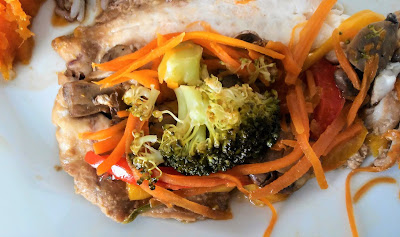Hachis
parmentier é um bolo de carne tradicional da culinária francesa, sendo seu nome uma homenagem
a Antoine Parmentier, nutricionista
dos séculos XVIII e XIX, que realizou pesquisas e publicou estudos sobre as
qualidades da batata, contribuindo assim para consolidar seu consumo na França.
Por outro lado, a palavra “hachis” é derivada do verbo “hacher”, que significa
moer ou cortar finamente. Na França, o hamburger por exemplo é chamado de “steak
haché”.
A base deste bolo é a carne bovina moída, algumas vezes
aproveitando sobras de outras refeições, cozida através de um refogado de cebola e,
por vezes, outros vegetais. Esta preparação é colocada num prato de ir ao
forno, coberta com puré de batata e assada até a superfície ficar dourada. No
entanto, o prato permite muitas variações, tanto nos ingredientes principais,
como nos condimentos e
mesmo na forma de preparação. A receita básica do puré de batata consiste em
misturar leite, manteiga e noz
moscada, sal e pimenta, ao purê de batata.
Uma variante consiste em colocar a carne entre duas camadas de
puré, como no bolo de carne português. A carne pode ser misturada com queijo gruyère
ou queijo suíço e ovos batidos, também pode ser cozida com tomate, cogumelos, alho-porro, abobrinha,
temperada com mostarda, chalotas, tomilho, cebolinho e vinho e
engrossada com creme ou farinha.
A receita a seguir foi baseado numa receita do chef francês
Claude Toisgros.
Ingredientes
·
800 g de batatas
· 200 g de cream cheese
·
200 g de creme de leite
·
Noz moscada, sal
·
1 cebola picada
·
2 alhos picados
·
¼ de dedo de moça picado (opcional)
·
1 colher de sopa de óleo vegetal (nós usamos de
girassol)
·
600 g de carne de boi moída
·
3 fatias finas de bacon ou a gosto
·
200 g de polpa de tomate
·
1 folha de louro
·
Salsa picada
·
Sal, pimenta do reino
·
100 g de queijo suíço ralado (opcional)
·
50 g de queijo parmesão ralado
Modo de preparo
1.
Cozinhe as batatas na água com sal (20 a 30
minutos)
2.
transforme em purê
3.
Coloque o purê no fogo e junte creme de leite e
cream cheese pouco a pouco até chegar à textura adequada
4.
Tempere com noz moscada e sal
5.
Misture bem.
1.
Salteie o bacon em um pouco de óleo
2.
Misture a carne moída com a cebola, o alho e o
louro. Tempere com sal e pimenta do reino e junte a carne ao bacon. Seque,
tostando bem.
3.
Coloque a polpa de tomate e a salsa. Salteie por
mais 1ou 2 minutos.
1.
Encha ¾ de um tabuleiro de vidro com a carne
2.
Cubra com a purê de batata
3.
Cubra com os 2 queijos ralados misturados
4.
Coloque no forno em 200º C, até gratinar
5.
Sirva
French Cottage Pie
(Hachis Parmentier)
Hachis parmentier is a traditional cottage pie from French
cuisine; its name being a tribute to Antoine Parmentier, nutritionist of the
18th and 19th centuries, who carried out research and published studies about
the qualities of potato, thus contributing to consolidate its consumption in
France. On the other hand, the word “hachis” is derived from the verb “hacher”,
which means to grind or finely cut. In France, the hamburger for example is
called "steak haché".
The base of this pie or cake is ground beef, sometimes using
leftovers from other meals, cooked through an onion stew and sometimes other
vegetables. This preparation is placed on an oven-proof dish, covered with
mashed potatoes and roasted until the surface is golden brown. However, the
dish allows many variations, both in the main ingredients, in the condiments
and even in the form of preparation. The basic recipe for mashed potatoes
consists of mixing milk, butter and nutmeg, salt and pepper, with mashed
potatoes.
A variant consists of placing the meat between two layers of
puree, as in the Portuguese pie. The meat can be mixed with gruyère or Swiss
cheese and beaten eggs, it can also be cooked with tomatoes, mushrooms, leek,
zucchini, seasoned with mustard, shallots, thyme, chives and wine and thickened
with cream or flour.
The following recipe was based on a recipe by French chef
Claude Toisgros.
Ingredients
Mashed potatoes
• 800 grams potatoes
• 200 grams cream cheese
• 200 grams cream
• Nutmeg, salt
Beef
• 1 chopped
onion
• 2 chopped garlic
• ¼ pepper (optional)
• 1 tablespoon vegetable oil (we use sunflower)
• 600 grams ground beef
• 3 thin slices of bacon or to taste
• 200 grams tomato pulp
• 1 bay leaf
• Chopped
parsley
• Salt, black pepper
Finish
• 100 grams grated Swiss cheese (optional)
• 50 grams grated Parmesan cheese
Directions
Mashed potatoes
1. Cook the potatoes in salted water (20-30 minutes)
2. Puree
3. Place the puree on the fire and add cream and cream
cheese little by little until it reaches the proper texture
4. Season with nutmeg and salt
5. Mix well.
Beef
1. Sauté the bacon in a little oil
2. Mix the ground beef with the onion, garlic and bay leaf.
Season with salt and pepper and add the meat to the bacon. Dry, toasting well.
3. Place the tomato pulp and parsley. Saute for another
minute.
Assembly
1. Fill ¾ of a baking dish with the beeef
2. Cover with mashed potatoes
3. Cover with the 2 grated mixed cheeses
4. Place in the oven at 200º C, until Golden (au gratin)
5. Serve






































